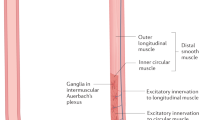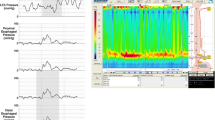Abstract
Achalasia is the best described motor disorderof the esophagus. Associations with familialglucocorticoid deficiency and alacrima (triple Asyndrome) have been described in the pediatricpopulation, but no attention has been paid to the possibilityof this association in adults. Tear production wasassessed in 20 patients with achalasia and 20 age- andsex-matched controls. Deficient tears were found in four achalasics compared with none among thecontrols (P < 0.05). This suggests that some variantof the triple A Syndrome (achalasia, alacrima, andadrenocortical insufficiency) may exist in adultpatients with achalasia as well.
Similar content being viewed by others
REFERENCES
Duranceau A, Pera M: Motor disorders of the oesophagus. Dis Oesophagus 8(3):159-166, 1995
Allgrove J, Clayden GS, Grant DB, Macaulay JC: Familial glucocorticoid deficiency with achalasia of the cardia and deficient tear production. Lancet i:1284–1286, 1978
Lanes R, Plotnick LP, Byrum TE, Lee PA, Casella JF, Fox CE: Glucocorticoid and partial mineralocorticoid deficiency associated with achalasia. J Clin Endocrinol Metab 50:268–270, 1980
Geffner ME, Lippe BM, Kaplan SA, Berquest WE, Bateman JB, Paterno VI, Seegan R: Selective ACTH insensitivity, achalasia, and alacrima; a multi-system disorder presenting in childhood. Pediatr Res 17:532–536, 1983
Duane TD, Jaeger EA: Clinical Ophthalmology, Harper & Row Publishers, Philadelphia, PA, Vol 4 p. 18, 1984
Clinch TE, Benedetto DA, Felberg NT, Laibson PR: Schirmer's test: A closer look. Arch Ophthalmol 101:1383–1386, 1983
Tsubota K: The importance of Schirmer's test with nasal stimulation. Am J Ophthalmol 111:106–108, 1991
Williamson J: Investigating signs and symptoms in dry eyed patients. Br J Ophthalmol 81(7):522, 1997 (editorial)
Tuck JS, Bisset RAL, Doig CM: Achalasia of the cardia in childhood and the syndrome of achalasia, alacrima and ACTH insensitivity. Clin Radiol 44:260–264, 1991
Grant DB, Barnes ND, Dumic M, Ginalska-Malinowska M, Milla PJ, Petrykowski WV, Rowlatt RJ, Steendijk R, Wales JHK, Wender E: Neurological and adrenal dysfunction in the adrenal insufficiency/alacrima/achalasia (3A) syndrome. Arch Dis Child 68(6):779–782, 1993
Simila S, Kokkonen J, Kaski M: Achalasia Sicca-Juvenile Sjogrens syndrome with achalasia and gastric hyposecretion. Eur J Pediatr 129:175–181, 1978
Efrati Y, Mares AJ: Infantile achalasia associated with defi-cient tear production. J Clin Gastroenterol 7:413–415, 1985
Khong PL, Peh WCG, Low LLY: Variant of the triple A syndrome. Australas Radiol 38:22–24, 1994
Moore PSJ, Couch RM, Perry YS, Shuckett EP, Winter JSD: Allgrove syndrome: An autosomal recessive syndrome of ACTH insensitivity, achalasia and alacrima. Clin Endocrinol 34:107–114, 1991
Stuckey BG, Mastalgia FL, Reed WD, Pullan PT: Glucocorticoid insufficiency, achalasia, alacrima with autonomic and motor neuropathy. Ann Intern Med 106:62–64, 1987
Ehrich E, Aranoff G, Johnson WG: Familial achalasia associated with adrenocortical insufficiency, alacrima and neurological abnormalities. Am J Med Genet 26:637–644, 1987
Dumic M, Radica A, Jusic A, Stefanovic N, Murko Z: Selective ACTH insensitivity associated with autonomic nervous system disorders and sensory polyneuropathy. J Pediatr 146:592–594, 1987
Dumic M, Radica A, Sabol Z, Plavsic V, Plavsic V, Brkljacic Lj, Sarnavkav V, Vukovic J: Adrenocorticotrophic hormone insensitivity associated with autonomic system disorders. Eur J Pediatr 150:696–699, 1991
Furners JB, Costa M: The Enteric Nervous System. New York, Churchill Livingstone, 1987
Qualman SJ, Haupt HM, Yong P, Hamilton SR: Esophageal Lewy body associated with ganglion cell loss in achalasia. Gastroenterology 87:848–856, 1984
Westely CR, Herbst JJ, Goldman S, Wiser WC: Infantile achalasia inherited as an autosomal recessive disorder. J Pediatr 87:243–246, 1975
Rights and permissions
About this article
Cite this article
Verma, S., Brown, S., Dakkak, M. et al. Association of Adult Achalasia and Alacrima. Dig Dis Sci 44, 876–878 (1999). https://doi.org/10.1023/A:1026679723941
Issue Date:
DOI: https://doi.org/10.1023/A:1026679723941




